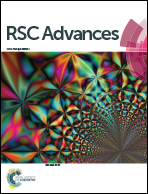Surface modification of TiO2 by an ionic liquid electrolyte in dye-sensitized solar cells using a molecular insulator
Abstract
A factor that limits the performance of dye-sensitized solar cells (DSC) based on ionic liquids is the disappearance of electron density due to electron recombination at the Dyed-TiO2/electrolyte interface. Adding an additive to the electrolyte can affect processes related to the kinetics of the electron recombination. In this paper a novel solid state additive, 1,2-dimethylimidazolium-3-propylsulfonate (DMImBS), was synthesized in an autoclave and directly applied to a DSC based on an ionic liquid electrolyte to form a molecular insulator layer. It was found that the presence of DMImBS in the ionic liquid electrolyte enhances both the open circuit photovoltage (Voc) and fill factor (FF) without significant penalizing the photocurrent (Jsc), as well as significantly increasing the power output of the DSC. This is suggested to be mainly due to the passivation of surface states, which effectively reduces electron recombination and restrains the Li+ intercalation. The device based on DMImBS also showed outstanding stability under prolonged light soaking at 50 °C, maintaining 100% photovoltaic efficiency.


 Please wait while we load your content...
Please wait while we load your content...